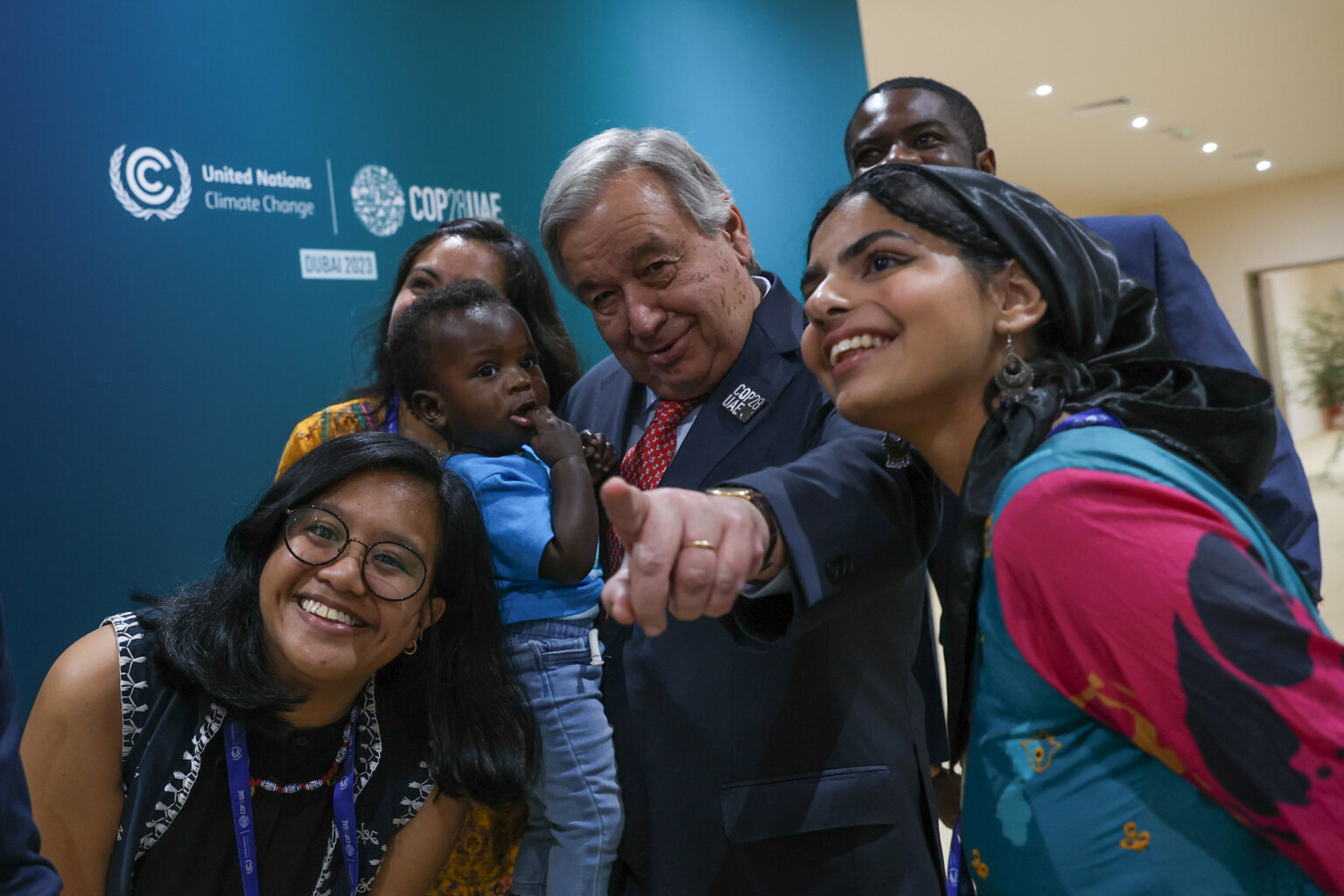What is the Conference of the Parties (COP)?
COP stands for Conference of the Parties. It brings together 198 “parties”, that is, the 197 countries and the European Union that have signed the United Nations Framework Convention on Climate Change (UNFCCC). Originating at the 1992 Earth Summit, the COP represents one of the international community’s most significant and far-reaching efforts to combat climate change.
According to the UNFCCC, the main objective of the Convention is “to avoid dangerous human interference with the climate system”.
Currently, 197 countries and the European Union attend the COPs, demonstrating near-universal concern and commitment to climate. It is important to understand that these Conferences are not merely formal meetings; they are the epicentre of multilateral climate discussions, which alternate annually among the five UN regional groups.
The main documents resulting from these Conferences are: The Kyoto Protocol and the Paris Agreement.
The Kyoto Protocol, adopted in 1997, was an initial milestone, legally binding developed countries to emission reduction targets. This Protocol went through two commitment periods, the first from 2008 to 2012 and the second starting in 2013 and ending in 2020.
However, it was the Paris Agreement, signed at the 21st COP held in 2015 in the French capital, that marked a new era in global climate policy. This agreement encouraged all nations to commit to fighting climate change and adapting to its effects, with the aim of keeping the global temperature increase below 2 degrees Celsius compared to pre-industrial levels and striving to limit this increase to 1.5 degrees Celsius.
The functions of the COP are twofold: to review the implementation of the Convention, the Kyoto Protocol, and the Paris Agreement; and to take decisions to improve and implement these instruments. This may include the creation of new subsidiary bodies and the negotiation of new legal instruments, such as the Paris Agreement itself and the Doha Amendment to the Kyoto Protocol.

Decision-making
The decision-making process at COPs is complex and involves extensive negotiations and compromises. This process not only reflects the diversity and concerns of participating countries, but also highlights the challenging nature of global climate governance.
Discussions between country leaders and negotiators should lead to a final text, adopted by consensus rather than by voting, which considers differences in interests and positions, with the ideal objective of making progress in the fight against the climate crisis. In addition to these negotiations, which often take longer than expected, the discussions bring together various lobby groups, NGO representatives and international organisations.
In addition to setting greenhouse gas (GHG) emissions reduction targets, COPs play a critical role in helping vulnerable communities adapt to the effects of climate change and in charting the path to achieving net zero emissions by 2050. This global commitment not only reflects the urgency of the climate crisis, but also represents an opportunity to reshape the global economy towards a low-carbon future that is environmentally responsible and socially just.
What does science say?
The science behind global warming is a robust and evolving field, marked by a growing and alarming understanding of climate change. Reports from scientists, researchers and affected communities around the world paint a worrying picture: abnormal variations in land and ocean temperatures, changes in the seasonal cycle and irregular rainfall patterns, all in excess of natural variability.
These changes are undoubtedly driven by global warming, a direct result of the increase of greenhouse gases (GHGs) in the atmosphere, mainly due to human activities such as the burning of fossil fuels and changes in land use.
Key climate science facts
– Rising GHGs: Since the Industrial Revolution, the concentration of GHGs has continued to increase, raising global temperatures.
– Temperature impact: Even small increases in global temperature have significant consequences, negatively affecting life and society.
– Need for urgent action: There is scientific consensus on the need for immediate action to mitigate additional GHG emissions and adapt to the present and future impacts of climate change.
The data used by the UNFCCC comes from organisations such as the World Meteorological Organization (WMO) and the Intergovernmental Panel on Climate Change (IPCC). The IPCC was established in 1988 by the World Meteorological Organization (WMO) and the United Nations Environment Programme (UNEP). At that time, there was already concern about global warming. Many studies on the subject were underway and the IPCC was created with the mission to evaluate the research, interpret it, and collate all relevant information, both technical and socio-economic, into comprehensive, easy-to-understand reports that were accessible to everyone.
The IPCC is organised into three working groups. Group I focuses on climate. Group II deals with the impacts of climate change and possible solutions. And Group III studies the economic and social dimensions of the effects of climate change.
Since its inception, the IPCC has published important reports. Its latest report states that “greenhouse gas emissions need to be reduced by 43% by 2030 compared to 2019 levels. This is crucial to limit the temperature increase to 1.5 degrees Celsius by the end of this century and to avoid the worst impacts of climate change, such as droughts, heat waves and more frequent and severe precipitation.”
A summary of the latest IPCC report:
The most recent report of the Intergovernmental Panel on Climate Change (IPCC) presents strong conclusions on the influence of human activities on global warming. The main conclusions are:
1. Global warming caused by human activities: Human activities, especially greenhouse gas (GHG) emissions, have unequivocally caused global warming. The global average surface temperature increased by 1.1°C above 1850-1900 levels in the period 2011-2020.
2. Continuing increase in GHG emissions: Global GHG emissions have been increasing, with uneven and historical contributions from excessive energy use, land-use changes, lifestyles, and consumption and production patterns.
3. Observed warming and its causes: Global surface temperatures have risen faster since 1970 than in any 50-year period in the last 2000 years. Atmospheric concentrations of CO2, methane and nitrous oxide are at their highest levels in millions of years.
4. Urgency of integrated near-term climate action: Climate-resilient development, integrating adaptation and GHG mitigation, is more urgent than ever. Every increase in warming, especially above 1.5°C, progressively restricts pathways towards climate-resilient development.
5. Risks of exceeding the warming limit: Limiting global warming to 1.5°C without temporarily exceeding this level is challenging. Adverse impacts during the overshoot period and feedback mechanisms such as forest fires and permafrost thaw make it difficult to return to safer levels.
6. Irreversible impacts and increasing risks: Increasing the magnitude and duration of the warming overshoot exposes ecosystems and societies to broader and more severe climate change, with irreversible impacts on some less resilient ecosystems.
7. Continued emissions and their effects: Continued emissions will affect all major components of the climate system, many of which will be irreversible on timescales of centuries to millennia.
8. Need for immediate action: Without urgent, effective, and equitable mitigation and adaptation actions, climate change increasingly threatens ecosystems, biodiversity and the livelihoods, health and well-being of current and future generations.
The report emphasises the rapidly closing window of opportunity to secure a liveable future for all, highlighting the critical importance of decisions and actions taken in this decade.
What can we expect from COP28?
The 28th Conference of the Parties (COP28) began on 30 November in Dubai, United Arab Emirates, and marks an important moment in the trajectory of international climate policy. Since the adoption of the Paris Agreement at COP21 in 2015, the focus has been on the effective implementation of its main objective: to limit global temperature rise to well below 2°C, with efforts to restrict the increase to 1.5°C above pre-industrial levels.
COP 28 promises to be a milestone, where the global community will not only outline the climate actions that need to be strengthened, but also demonstrate concrete methodologies for their implementation.
A central focus of COP28 will be the identification of global solutions to keep global temperature increase within the stipulated limits. This implies a particular focus on the development of revised and more ambitious NDCs (Nationally Determined Contributions), due by 2025, which are crucial to drive the transition to a green economy and meet the Paris Agreement targets.
Another crucial aspect is the conclusion of the first Global Stocktake, which started in Glasgow, an essential process to review collective progress towards the Paris Agreement goals and guide countries towards more ambitious and accelerated climate action.
In addition, the Conference will address several key areas:
● Loss and damage financing: Development of financial mechanisms to help vulnerable communities cope with the direct impacts of climate change.
● Global finance target: Development of global financial targets to help developing countries act on climate change.
● Just Energy Transition: Accelerate the transition to renewable energy sources, considering the socio-economic needs of affected communities, emphasising the need to accelerate the energy transition and reduce emissions by 2030.
● Closing the emissions gap: urgent strategies to reduce global emissions and meet climate targets.
● Phasing out fossil fuels: COP28 will face the challenge of formulating a global agreement to phase out fossil fuels by 2050, considering historical responsibilities and promoting development equity for the poorest countries.
● Putting people at the centre of climate action: for the first time at a COP summit, a full day of the agenda will be devoted to initiatives designed to “protect” lives and livelihoods, support resilience and the stability of communities” in the face of the advancing impacts of climate change. There will be high-level discussions on health, relief, recovery, and peace, with a focus also on regions of the world consumed by conflict and beset by a range of challenges that make climate change mitigation and adaptation extremely difficult.
● Broader leadership on climate change: COP28 will also seek to engage a broader range of leaders to turn climate promises into action. The COP28 Local Climate Action Summit will bring together hundreds of mayors, governors, business, and NGO leaders who play a key role in implementing climate policies at the municipal and regional level in their home countries.
What is the role of youth?
Young people occupy a strategic position in building a healthier future for generations to come. With climate change increasingly recognised as a global threat to health and well-being, young people are taking a proactive and essential role in combating this challenge.
They not only raise awareness of the impact of climate on health and well-being, but also encourage lifestyle changes and lobby for effective policy action.
Adopting healthy lifestyles
Young people are at the forefront of adopting healthy lifestyles. They are making changes to their daily routines, such as using public transport, adopting plant-based diets, reducing food waste, and avoiding single-use plastics. These individual actions, however small, contribute significantly to reducing the environmental footprint.

Defence and advocacy
Young people are actively engaged in advocacy, sharing knowledge on climate change, and promoting sustainability discussions in their communities. They use online platforms and social media to connect with other young people and influence policy and behavioural decisions.
Participation in global initiatives
Initiatives such as UNICEF’s Voices of Youth and the UN Youth Climate Summit provide platforms for young people to share their views and actively participate in climate discussions and actions.
If we talk specifically about COPs, young people can get involved in different actions and initiatives such as the International Youth Conference (COY) and YOUNGO.
COY is a leading gathering focused on climate movements, which serves as a global platform and aims to bring together young people from different countries, policy makers and researchers to discuss crucial issues such as international climate policy.
YOUNGO is a “constituency”, a formal group that allows young people to have an organised voice in climate-related decision-making processes, recognised in 2009 under the UNFCCC, bringing together youth movements and NGOs from around the world. Its main objective is to encourage the participation of young people working on the process of reducing gas emissions from deforestation and forest degradation; on the issue of adaptation and mitigation in the context of climate change; on the principle of intergenerational equity; on the financial crisis and technological progress. YOUNGO has no hierarchical structure or leader, only two focal points that coordinate activities: one represents the southern hemisphere and the other the north. Being a “constituency” allows YOUNGO to have a space to hold its “daily meeting”, to plan interventions during the COP plenaries.
These spaces offer the opportunity to discuss solutions and collaborate with other young people from around the world.
Training and capacity building
Training and mentoring programmes are equipping young people with the skills and knowledge they need to become effective climate leaders and advocates. They are learning how to monitor air quality, develop environmentally responsible and socially just projects and actively engage in dialogue with local and global authorities.
Conclusion:
In summary, the Conference of the Parties (COP) represents a major milestone in the global fight against climate change, demonstrating a near-universal commitment to climate action through the participation of 197 countries and the European Union.
COPs are much more than just formal meetings, they function as the epicentre of multilateral climate discussions, alternating annually between UN regional groups. The legacy of these conferences includes crucial documents such as the Kyoto Protocol and the Paris Agreement.
The science of global warming, as evidenced by reports from the IPCC and the World Meteorological Organisation (WMO), reveals a worrying picture, with the continued rise in greenhouse gases (GHGs) raising global temperatures and causing significant adverse effects on life and society.
COP28, held in Dubai, focuses on the effective implementation of the Paris Agreement and on identifying global solutions to keep global temperature rise within safe limits. With an emphasis on developing revised and more ambitious NDCs, COP28 aims to promote a just energy transition and accelerate climate action.
Finally, young people play a crucial role, adopting healthy lifestyles, advocating for climate action, and participating in global initiatives, demonstrating the importance of educating and empowering young people in climate debates and actions.



